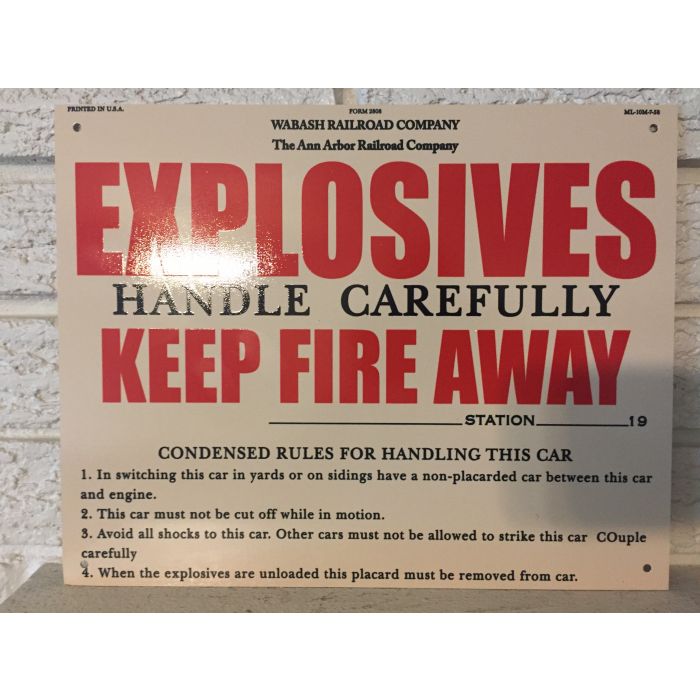Wabash Ann Arbor Railroad era Explosives Boxcar Aluminum Sign New 9.25x11.75 DL
$33.95
In stock
SKU
000087
Wabash Ann Arbor Railroad era "Explosives Handle Carefully Keep Fire Away" Boxcar .040 Aluminum Sign New 9.25x11.75 . Reproduction of an actual Circa 1958 boxcar sign. Ready for hanging in that Railroad Room. #2320
The history of the Ann Arbor Railroad (AA) began with two companies organized in 1869 and 1872 to build a railroad between Toledo, Ohio and Ann Arbor, Michigan, approximately 45 miles (72 kilometres). The Panic of 1873 killed one of those two companies; it took another 20 years and 12 companies, most of them named Toledo, Ann Arbor & something, for the railroad to reach the eastern shore of Lake Michigan at Frankfort, Michigan. (The Toledo-Frankfort line was the railroad's sole route until the 1960s, when it acquired its only branch, a 4 mi (6.4 km) New York Central Railroad remnant from Pittsfield to Saline, Michigan.) From Elberta, across a small inlet from Frankfort, the Ann Arbor operated train ferry lines to Kewaunee and Manitowoc, Wisconsin, and Menominee and Manistique, Michigan. The AA was incorporated in 1895 as a reorganization of the Toledo, Ann Arbor and North Michigan Railway.[1][2]
The Detroit, Toledo & Ironton Railway (DT&I) obtained control of the AA in 1905 but sold its interests in 1910. In 1911 the AA purchased all the capital stock of the Manistique & Lake Superior Railroad (M&LS), which extended north from the Manistique, Michigan, to connections with the Duluth, South Shore & Atlantic Railway and the Lake Superior & Ishpeming Railroad.[1]
In 1925 the Wabash Railroad, which was controlled by Pennsylvania Railroad (PRR) interests, acquired control of the AA. By 1930 it held more than 97% of AA's stock. AA was in receivership from December 4, 1931, to January 1, 1943 but did not reorganize.[1] Never a major passenger carrier, AA discontinued its last passenger train in 1950 and gave its to full attention to freight service, which was largely made up of through freight using the Lake Michigan ferries to bypass Chicago and take advantage of lower rates. The railroad was completely dieselized by 1951.[1] In 1963, the Wabash sold the AA to the DT&I (which was owned by the Wabash and the PRR). The M&LS and the connecting 100 mi (160 km) train ferry route were abandoned in 1968. In 1970 the Interstate Commerce Commission authorized abandonment of the ferry route between Frankfurt and Menominee (80 miles (130 kilometres)) and the facilities at Menominee.[1]
Chicago
Mackinaw mackinac st ignace Houghton Grand Rapids Warren Sterling Heights Lansing Ann Arbor Flint Dearborn Livonia Westland Troy Westland Farmington Hills Kalamazoo Southfield St. Clair Shores Novi Battle Creek Saginaw Roseville Mackinaw mackinac st ignace Houghton Grand Rapids Warren Sterling Heights Lansing Ann Arbor Flint Dearborn Livonia Westland Troy Westland Farmington Hills Kalamazoo Southfield St. Clair Shores Novi Battle Creek Saginaw Roseville Ypsilanti Howell Durand Owasso frankfurt
Wabash Ann Arbor Railroad era "Explosives Handle Carefully Keep Fire Away" Boxcar .040 Aluminum Sign New 9.25x11.75 . Reproduction of an actual Circa 1958 boxcar sign. Ready for hanging in that Railroad Room. #2320
The history of the Ann Arbor Railroad (AA) began with two companies organized in 1869 and 1872 to build a railroad between Toledo, Ohio and Ann Arbor, Michigan, approximately 45 miles (72 kilometres). The Panic of 1873 killed one of those two companies; it took another 20 years and 12 companies, most of them named Toledo, Ann Arbor & something, for the railroad to reach the eastern shore of Lake Michigan at Frankfort, Michigan. (The Toledo-Frankfort line was the railroad's sole route until the 1960s, when it acquired its only branch, a 4 mi (6.4 km) New York Central Railroad remnant from Pittsfield to Saline, Michigan.) From Elberta, across a small inlet from Frankfort, the Ann Arbor operated train ferry lines to Kewaunee and Manitowoc, Wisconsin, and Menominee and Manistique, Michigan. The AA was incorporated in 1895 as a reorganization of the Toledo, Ann Arbor and North Michigan Railway.[1][2]
The Detroit, Toledo & Ironton Railway (DT&I) obtained control of the AA in 1905 but sold its interests in 1910. In 1911 the AA purchased all the capital stock of the Manistique & Lake Superior Railroad (M&LS), which extended north from the Manistique, Michigan, to connections with the Duluth, South Shore & Atlantic Railway and the Lake Superior & Ishpeming Railroad.[1]
In 1925 the Wabash Railroad, which was controlled by Pennsylvania Railroad (PRR) interests, acquired control of the AA. By 1930 it held more than 97% of AA's stock. AA was in receivership from December 4, 1931, to January 1, 1943 but did not reorganize.[1] Never a major passenger carrier, AA discontinued its last passenger train in 1950 and gave its to full attention to freight service, which was largely made up of through freight using the Lake Michigan ferries to bypass Chicago and take advantage of lower rates. The railroad was completely dieselized by 1951.[1] In 1963, the Wabash sold the AA to the DT&I (which was owned by the Wabash and the PRR). The M&LS and the connecting 100 mi (160 km) train ferry route were abandoned in 1968. In 1970 the Interstate Commerce Commission authorized abandonment of the ferry route between Frankfurt and Menominee (80 miles (130 kilometres)) and the facilities at Menominee.[1]
Chicago
Mackinaw mackinac st ignace Houghton Grand Rapids Warren Sterling Heights Lansing Ann Arbor Flint Dearborn Livonia Westland Troy Westland Farmington Hills Kalamazoo Southfield St. Clair Shores Novi Battle Creek Saginaw Roseville Mackinaw mackinac st ignace Houghton Grand Rapids Warren Sterling Heights Lansing Ann Arbor Flint Dearborn Livonia Westland Troy Westland Farmington Hills Kalamazoo Southfield St. Clair Shores Novi Battle Creek Saginaw Roseville Ypsilanti Howell Durand Owasso frankfurt
Write Your Own Review

